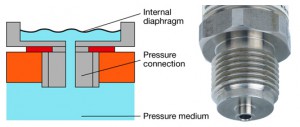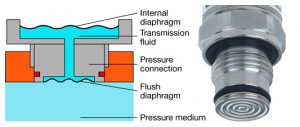
The term “wetted parts” is used in connection with pressure sensors for all those parts, surfaces and/or components that are (potentially) exposed to or in direct contact with the medium under pressure. In case of a typical pressure sensor this is mainly limited to those parts of the pressure sensor called “process connection” or pressure port, i.e. the parts via which the pressure sensor actually ”connects” to the process.
Typically in the US this is a standard thread like ¼” NPT, ½” NPT or G¼”, G 1/2” (male or female). It is important to notice that it not only comprises the materials used in the construction of the device but also extends to any seals or gaskets that are required for the particular thread in questions- like PTFE-tape for conical threads or O-rings for cylindrical threads- a small but important detail that is often overlooked. Furthermore the term “wetted parts” also includes any internal seals, welds or membranes/ diaphragms of the pressure sensor that are (at least partially) in contact with the media used.
Typically wetted parts of pressure sensors are from four categories:
Ferrous materials (like carbon steel, stainless steel etc.)
Mainly used for main bodies/ housings of sensors and threads etc. The majority of pressure ports and process connections on industrial pressure sensors are nowadays made from stainless steel and thin-film sensors mainly use steel as the base material for the sensor body- but the term can be misleading as it seems to imply universal corrosion resistance, which is not the case. Always check for the specific grade of stainless steel and check corrosion resistance and chemical compatibility carefully.
Non-ferrous materials (like Copper, Brass, Gold, Hastelloy, Elgiloy, Titanium etc.)
Typically used as metallic sealings or in special designs for sensor bodies, membranes, or on diaphragms as coatings. In more economical applications, brass is still a material common for valves and fittings and therefore is also used to build pressure sensors. For special applications sometimes the use of titanium or specialty alloys (like Elgiloy, Hastelloy, or Inconel) is required to provide high corrosion resistance or superior measurement performance. Some elements (like Gold) are sometimes used to coat membranes and diaphragms as a protection against corrosion and chemical attack or to prevent Hydrogen to pass through. The cost of some of those materials and/ or the difficult handling and machining can be prohibitive in certain applications.
Elastomers and Plastics (like PA, Viton, PTFE etc.)
typically used as gaskets, seals or coatings for diaphragms Plastics and Elastomers are used mainly for O-rings or as gaskets and seals, Specialty plastics like PTFE are sometimes used as a protective coating for membranes and diaphragms.
Ceramics (like AL2O3)
Typically used as a sensor body/ diaphragm for capacitive or thick-film resistive pressure sensors The use of ceramics as a sensor material promises high chemical compatibility and temperature stability that is unfortunately quite often compromised because ceramics cannot be hermetically sealed by welding but always requires the use of (soft) sealing materials-which then becomes the limiting factor and leads to product variance and because the seal is hidden inside, can lead to inadvertently selecting the wrong sealing, hence sensor.
Figure 1: Typical wetted Parts of Pressure sensors- anything that comes in contact with the media (light blue)



